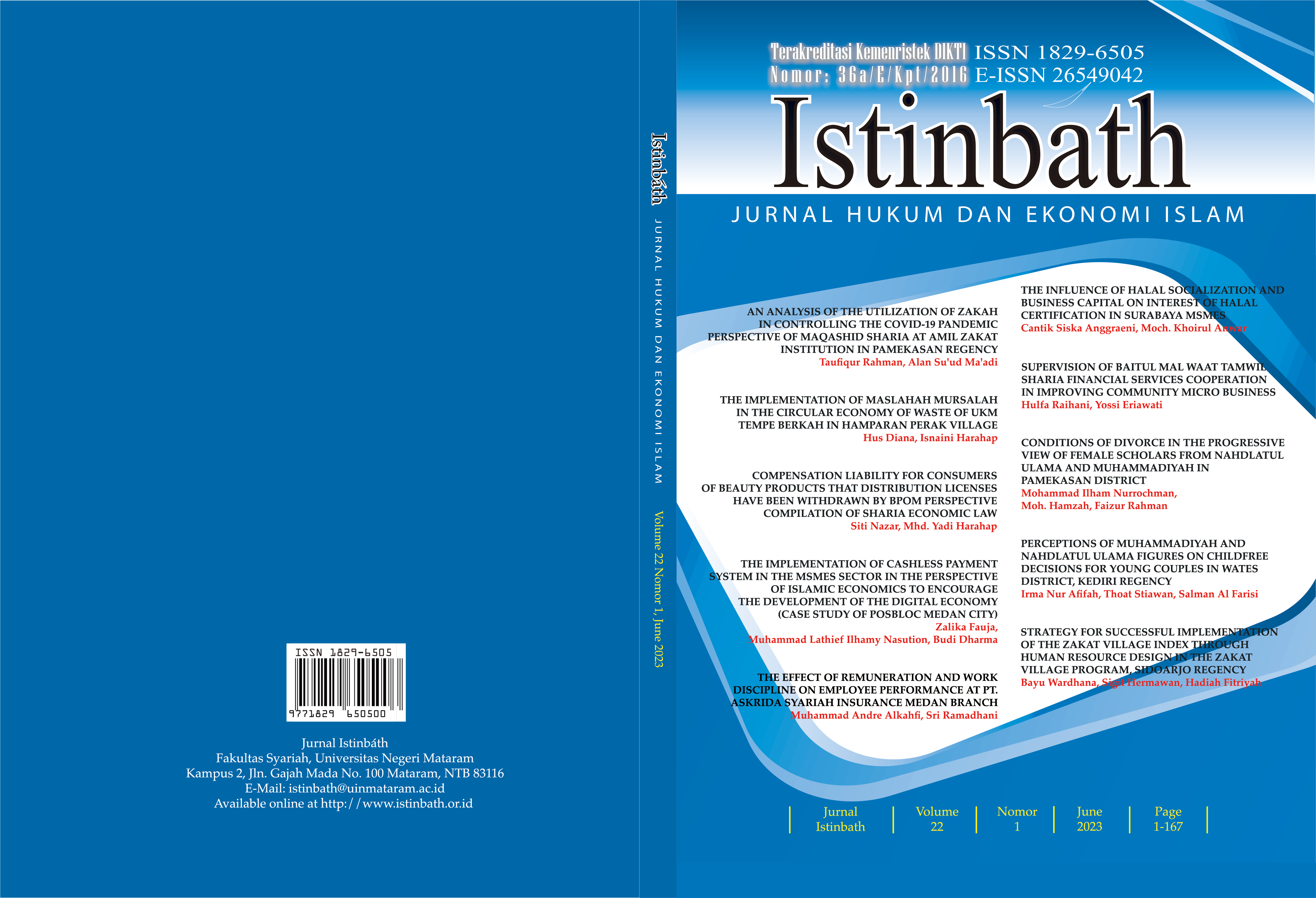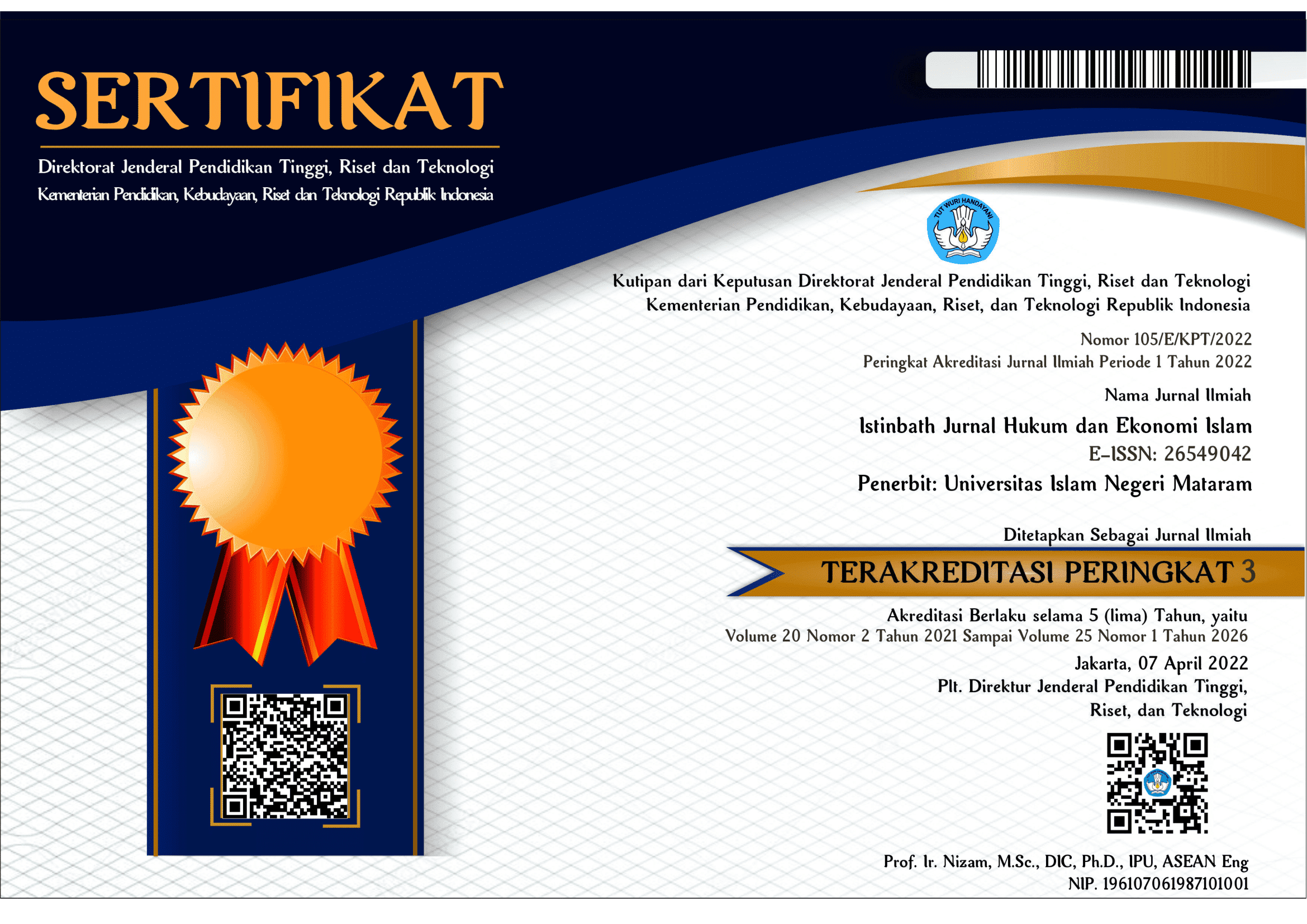PERCEPTIONS OF MUHAMMADIYAH AND NAHDLATUL ULAMA FIGURES ON CHILDFREE DECISIONS FOR YOUNG COUPLES IN WATES DISTRICT, KEDIRI REGENCY
DOI:
https://doi.org/10.20414/ijhi.v22i1.596Keywords:
childfree, young couples, perception, muhammadiyah figures, nahdlatul ulama figuresAbstract
Childfree is a decision taken by married couples not to have children. The decision was taken consciously by mutual consent. It is also related to the current trend among young couples not to have children because they feel reluctant to be responsible for their children’s lives and focus on household life as a childless married couple. Apparently, this has also been accepted and validated by several young couples in Wates District, Kediri Regency. Of course, regarding Childfree itself, there is no Islamic law that regulates it, so, in this case, the author uses the perceptions of Muhammadiyah and Nahdlatul Ulama figures to give their views on the Childfree phenomenon among young couples in Wates District, Kediri Regency. This research uses a qualitative approach with descriptive methods. Data collection by interviews and observations of Nahdlatul Ulama and Muhammadiyah figures in Wates District, Kediri Regency. The results of this study indicate that there are various viewpoints regarding childfree, but what has become the agreement of NU and Muhammadiyah figures in Wates District, Kediri Regency, regarding Childfree is that they tend to disagree and encourage young couples to return to their religious knowledge, and to take a holistic approach regarding making that decision. Childfree actions should not be used as a benchmark or a guide in building a household that is sakinah, mawaddah, and rahmah because these actions injure the nature of marriage.
References
Al Faris, S. (2021). Childfree Dalam Perspektif Fiqh al-Aulawiyyat. Maqasid: Jurnal Studi Hukum Islam, 10(2), 1–9.
Baihaqi, Y. (2017). Moderasi Hukum Keluarga dalam Perspektif Al Qur’an. Istinbáth Jurnal Hukum Dan Ekonomi Islam, 16(2), 365–389
Barha, C. K., Hanna, C. W., Salvante, K. G., Wilson, S. L., Robinson, W. P., Altman, R. M., & Nepomnaschy, P. A. (2016). Number of Children and Telomere Length in Women: A Prospective, Longitudinal Evaluation. PLOS ONE, 11(1), 1–12
Damayanti, I., & Fitriyani, E. (2021). Pelatihan Pranikah Berbasis Pengetahuan dan Keterampilan Bagi Pasangan Yang Akan Menikah Pada KUA Marpoyan Damai Pekanbaru. Menara Riau, 14(1), 33, https://doi.org/10.24014/menara.v14i1.12482
Fauzan, A. (2022). Childfree Perspektif Hukum Islam. As Salam Jurnal Studi Hukum Islam Dan Pendidikan, 11(1), 1–10
Indah, D. N., & Zuhdi, S. (2022). The Childfree Phenomenon in the Perspective of Human Rights and Maqashid Al-Shari’ah: Atlantis Press, 661, https://doi.org/10.2991/assehr.k.220501.025
Khusairi, H., & Mandala, I. (2022). Perkawinan Adat Analisis Hukum dan Sistem Perkawinan di Kerinci Dalam Perspektif Hukum Islam. Istinbáth Jurnal Hukum Dan Ekonomi Islam, 21(22), 227–436
Komala, D. M., & Warmiyati D.W, M. T. (2022). Proses Pengambilan Keputusan Pada Pasangan Suami Istri Yang Memilih Untuk Tidak Memiliki Anak. Jurnal Muara Ilmu Sosial, Humaniora, Dan Seni, 6(1), 119–128
McQuillan, J., Greil, A. L., White, L., & Jacob, M. C. (2003). Frustrated Fertility: Infertility and Psychological Distress Among Women. Bureau of Sociological Research, 1006–1018
Mingkase, N., & Rohmaniyah, I. (2022). Konstruksi gender dalam problematika childfree disosial media Twitter. Yinyang Jurnal Studi Islam, Gender, Dan Anak, 17(2), 201–222
Nugroho, D. A., Alfarisy, F., Kurniawan, A. N., Rahma, E., & Sarita, E. R. (2022). Tren Childfree dan Unmarried di kalangan Masyarakat Jepang. Comserva Jurnal Penelitian Dan Pengabdian Masyarakat, 1(11), 1023–1030
Rahmadanti, K. A. (2022). Childfree Menurut Undang-Undang Nomor 39 Tahun 1999 Tentang Hak Asasi Manusia [IAIN Kediri], http://etheses.iainkediri.ac.id/6267
Ramadhani, K. W., & Tsabitah, D. (2022). Fenomena Childfree dan Prinsip Idealisme Keluarga Dalam Perspektif Mahasiswa. LoroNG: Media Pengkajian Sosial Budaya, 11(1), 17–29
Republik Indonesia. (1974). Undang-Undang Republik Indonesia Nomor 1 Tahun 1974 Tentang Perkawinan. DPR, https://www.dpr.go.id/dokjdih/document/uu/742.pdf
Siauw, F. (2020). Ngaji Jomblo 02: Nikah Itu Mulai Dari Persepsi. Spotify. https://podcasters.spotify.com/pod/show/felix-siauw/episodes/Ngaji-Jomblo-02- Nikah-Itu-Mulai-Dari-Persepsi-ecugo2
Siswanto, A. W., & Nurhasanah, N. (2022). Analisis Fenomena Childfree di Indonesia. Bandung Conference Series: Islamic Family Law, 2(2), 64–70, https://doi.org/10.29313/bcsifl.v2i2.2684
Sudarto, A. (2014). Studi Deskriptif Kepuasan Perkawinan Pada Perempuan Yang Menikah Dini. 3(1), 1–15
Sugiyono. (2015). Metode Penelitian Pendidikan (22nd ed.). Alfabeta
Tim Media Indonesia. (2021). Fenomena Childfree di Indonesia [Humaniora]. Media Indonesia, https://epaper.mediaindonesia.com/detail/fenomena-childfree-di- indonesia
Ustad Agus Imron. (2023, March 26). Wawancara Tokoh Nahdlatul Ulama [Personal communication]
Ustad Mohammad Dofir. (2023, March 22). Wawancara Tokoh Muhammadiyah [Personal communication]
Ustad Mohammad Erwanto. (2023, March 21). Wawancara Tokoh Muhammadiyah [Personal communication]
Ustad Muhammad Roihan Mahmud. (2023, March 26). Wawancara Tokoh Nahdlatul Ulama [Personal communication]
Ustad Pairin. (2023, March 20). Wawancara Tokoh Muhammadiyah [Personal communication]
Ustadz Farid Waidi Sukir. (2023, March 26). Wawancara Tokoh Nahdlatul Ulama [Personal communication]
Warada, A., Mardiana, & Hasanah, I. A. (2021). Urgensi Peran Keluarga Terhadap Pembinaan Karakter Generasi Muda Sebagai Pilar Ketahanan Nasional. Jurnal Pengajaran Dan Kajian Islam, 1(1), 19–26
Widyasari, C., & Hidayat, T. (2022). Tinjauan Maslahah Mursalah terhadap Fenomena Childfree. 20(2), 399–414





